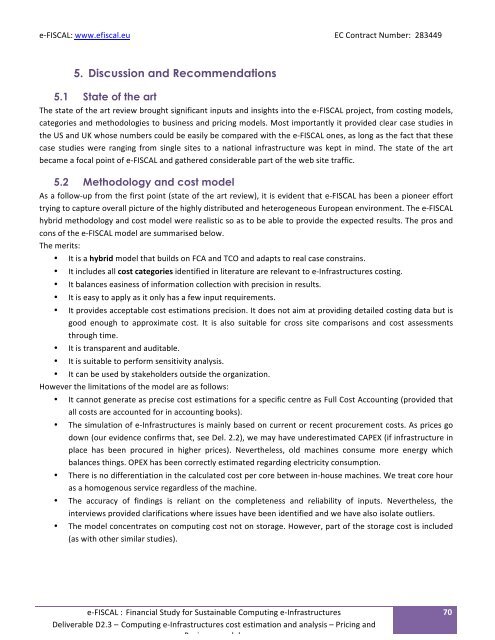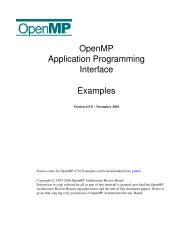D2 3 Computing e-Infrastructure cost calculations and business _models_vam1-final
D2 3 Computing e-Infrastructure cost calculations and business _models_vam1-final
D2 3 Computing e-Infrastructure cost calculations and business _models_vam1-final
Create successful ePaper yourself
Turn your PDF publications into a flip-book with our unique Google optimized e-Paper software.
e-‐FISCAL: www.efiscal.eu <br />
EC Contract Number: 283449 <br />
5. Discussion <strong>and</strong> Recommendations<br />
5.1 State of the art<br />
The state of the art review brought significant inputs <strong>and</strong> insights into the e-‐FISCAL project, from <strong>cost</strong>ing <strong>models</strong>, <br />
categories <strong>and</strong> methodologies to <strong>business</strong> <strong>and</strong> pricing <strong>models</strong>. Most importantly it provided clear case studies in <br />
the US <strong>and</strong> UK whose numbers could be easily be compared with the e-‐FISCAL ones, as long as the fact that these <br />
case studies were ranging from single sites to a national infrastructure was kept in mind. The state of the art <br />
became a focal point of e-‐FISCAL <strong>and</strong> gathered considerable part of the web site traffic. <br />
5.2 Methodology <strong>and</strong> <strong>cost</strong> model<br />
As a follow-‐up from the first point (state of the art review), it is evident that e-‐FISCAL has been a pioneer effort <br />
trying to capture overall picture of the highly distributed <strong>and</strong> heterogeneous European environment. The e-‐FISCAL <br />
hybrid methodology <strong>and</strong> <strong>cost</strong> model were realistic so as to be able to provide the expected results. The pros <strong>and</strong> <br />
cons of the e-‐FISCAL model are summarised below. <br />
The merits: <br />
• It is a hybrid model that builds on FCA <strong>and</strong> TCO <strong>and</strong> adapts to real case constrains. <br />
• It includes all <strong>cost</strong> categories identified in literature are relevant to e-‐<strong>Infrastructure</strong>s <strong>cost</strong>ing. <br />
• It balances easiness of information collection with precision in results. <br />
• It is easy to apply as it only has a few input requirements. <br />
• It provides acceptable <strong>cost</strong> estimations precision. It does not aim at providing detailed <strong>cost</strong>ing data but is <br />
good enough to approximate <strong>cost</strong>. It is also suitable for cross site comparisons <strong>and</strong> <strong>cost</strong> assessments <br />
through time. <br />
• It is transparent <strong>and</strong> auditable. <br />
• It is suitable to perform sensitivity analysis. <br />
• It can be used by stakeholders outside the organization. <br />
However the limitations of the model are as follows: <br />
• It cannot generate as precise <strong>cost</strong> estimations for a specific centre as Full Cost Accounting (provided that <br />
all <strong>cost</strong>s are accounted for in accounting books). <br />
• The simulation of e-‐<strong>Infrastructure</strong>s is mainly based on current or recent procurement <strong>cost</strong>s. As prices go <br />
down (our evidence confirms that, see Del. 2.2), we may have underestimated CAPEX (if infrastructure in <br />
place has been procured in higher prices). Nevertheless, old machines consume more energy which <br />
balances things. OPEX has been correctly estimated regarding electricity consumption. <br />
• There is no differentiation in the calculated <strong>cost</strong> per core between in-‐house machines. We treat core hour <br />
as a homogenous service regardless of the machine. <br />
• The accuracy of findings is reliant on the completeness <strong>and</strong> reliability of inputs. Nevertheless, the <br />
interviews provided clarifications where issues have been identified <strong>and</strong> we have also isolate outliers. <br />
• The model concentrates on computing <strong>cost</strong> not on storage. However, part of the storage <strong>cost</strong> is included <br />
(as with other similar studies). <br />
e-‐FISCAL : Financial Study for Sustainable <strong>Computing</strong> e-‐<strong>Infrastructure</strong>s <br />
Deliverable <strong>D2</strong>.3 – <strong>Computing</strong> e-‐<strong>Infrastructure</strong>s <strong>cost</strong> estimation <strong>and</strong> analysis – Pricing <strong>and</strong> <br />
Business <strong>models</strong> <br />
70




